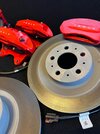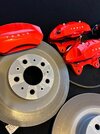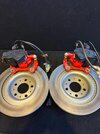Tesla engineers may have changed the rear brakes from Brembo to Mando, with smaller calipers because they know it does not make a difference in braking ability. The front brakes perform most of a vehicle's friction braking.
The Gen3 Formula E cars have no rear brakes. That's right, none. The Gen3 Formula E race cars will deliver 350kW at the rear drive and be able to reach 200 MPH. The third generation Formula E race cars will rely on front friction brakes and up to 600 kW of regenerative braking combined from both the front and rear. At this time the front motor only provides regenerative braking, all propulsion is via the rear motor. The maximum charging rate will be 600 kW; each Formula E car will have to stop for a quick charge during every race.
Formula E's faster Gen3 car starts season 9 Saturday in Mexico City







